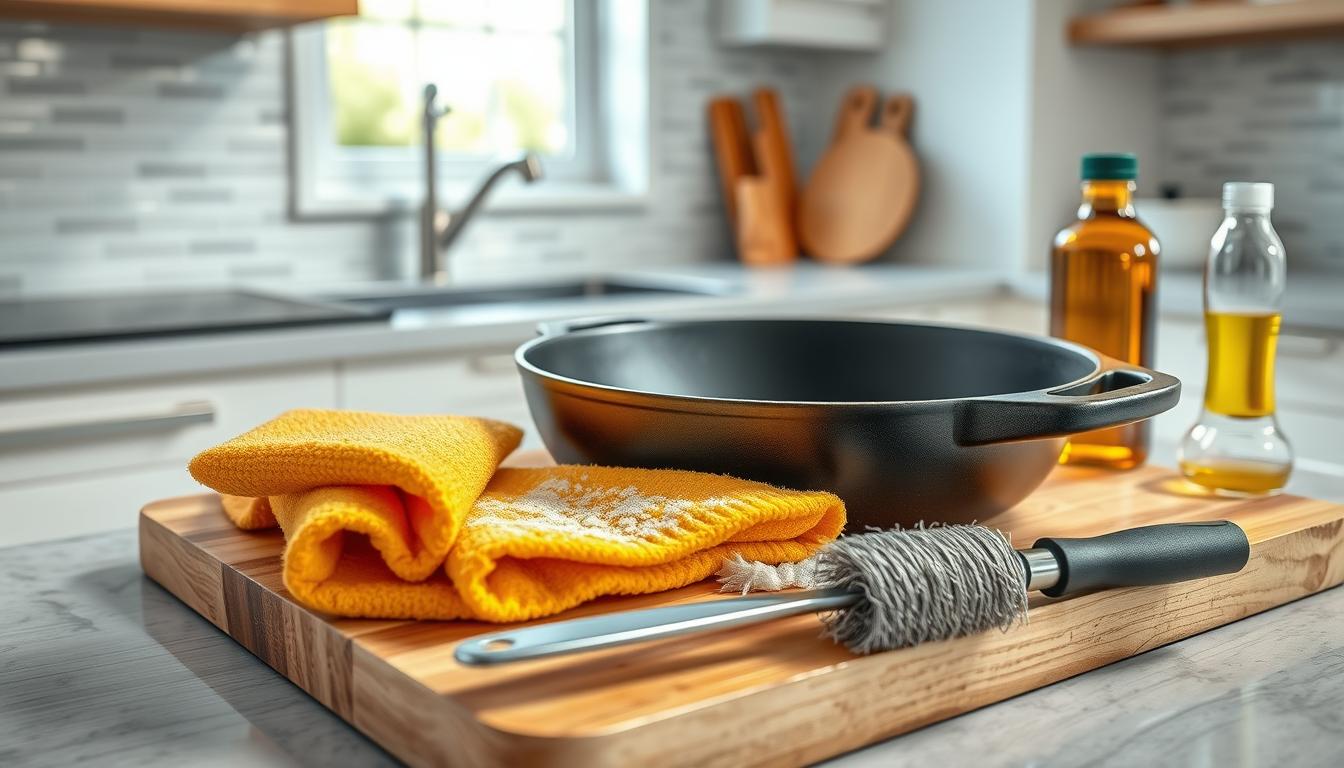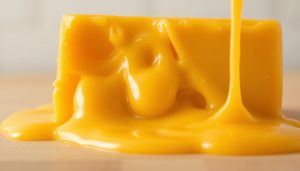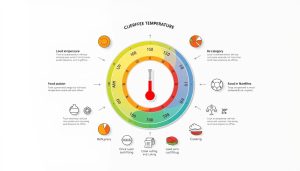Did you know 40% of cast iron cookware gets thrown away because of rust? Your favorite skillet might still have decades of service left – if you know how to revive it properly. Cast iron pans can last for generations with the right care, yet many people don’t realize how durable they are.
Seasoned chefs and family cooks face the same problem: rust happens. Whether it’s a forgotten camping pan or a treasured family heirloom, rust doesn’t have to mean the end. Modern methods can restore even the most oxidized pans, keeping their natural non-stick surface.
Proper care begins with understanding why cast iron rusts. Moisture, poor drying, or thin seasoning layers are common culprits. The bright side? Non-abrasive cleaning methods and smart storage can stop 90% of rust problems before they begin.
Key Takeaways
- Surface oxidation doesn’t mean your pan is beyond repair
- Specialized cleaning methods preserve cooking performance
- Seasoning maintenance prevents future corrosion
- Vertical storage reduces moisture exposure
- Climate-controlled spaces extend cookware lifespan
- Heritage pieces require tailored restoration approaches
After years of testing, we’ve found the best ways to fight rust without harming your cookware. These methods work for both modern Lodge skillets and old Griswold collections. Let’s look at storage tips that keep your cookware safe and make your kitchen more efficient.
Understanding Rust Formation on Cast Iron
Ever wondered why your cast iron skillet gets those orange-brown spots? It’s all about chemistry and how you care for it. Understanding how rust forms is key to stopping it. Let’s explore the process and common mistakes.

The Science Behind Metal Oxidation
Rust happens when iron, oxygen, and water meet. This mix creates iron oxide (FeO(OH)), which weakens your cookware.
Iron + Oxygen + Moisture Reaction
Water touching metal starts an electrochemical reaction. This reaction speeds up in humid places. Even tiny water droplets from washing can cause rust in hours.
Why Cast Iron Is Particularly Vulnerable
Cast iron has 2-4% carbon, unlike stainless steel. Its porous structure offers more surface area for reactions. “Think of it like a sponge soaking up moisture instead of repelling it,” says Dr. Ellen Torres.
| Material | Carbon Content | Rust Resistance |
|---|---|---|
| Cast Iron | 2-4% | Low |
| Stainless Steel | 1% | High |
| Carbon Steel | 1-2% | Medium |
Common Causes of Rust Buildup
Most rust problems come from avoidable mistakes. Knowing these can help keep your cookware in top shape.
Improper Drying Techniques
Not drying pans properly traps moisture. Always heat-dry them on the stove for 5 minutes after washing. This also renews the seasoning.
Long-Term Storage Mistakes
Storing pans without protection can cause friction. This wears off the seasoning. Use these tips:
- Place paper towels between nested pieces
- Store in low-humidity areas (avoid under sinks)
- Apply thin oil coating every 3 months
Damage to Seasoning Layer
Using steel wool or acidic foods can damage the seasoning. This leaves the metal exposed to rust. Use these safe cleaning tools:
- Nylon brushes
- Coarse salt paste
- Plastic scrapers
“Rust prevention starts the moment you finish cooking – proper drying and oiling habits are non-negotiable.”
Essential Tools for Rust Removal
You need specific tools to restore your skillet without damaging its seasoned surface. Some rust removal techniques use everyday kitchen staples. Others require specialized equipment. The right approach balances effectiveness with preservation, ensuring your clean cast iron skillet stays rust-free for years.

Basic Household Supplies
Common pantry items can tackle light to moderate rust when used correctly. Always test these methods on small areas first to prevent unintended seasoning loss.
White Vinegar Solutions
A 50% vinegar-water mix dissolves rust in 30-60 minutes. Recent tests show this concentration removes oxidation 40% faster than weaker solutions while remaining safe for most cookware. Rinse thoroughly afterward to prevent acidic residue.
Baking Soda Pastes
Combine baking soda with water to create a non-abrasive scrub. This paste neutralizes remaining vinegar acids after treatment and polishes surfaces. For stubborn spots:
- Apply paste to damp skillet
- Let sit 15 minutes
- Scrub with soft brush
Specialized Cleaning Tools
Invest in these durable tools if you regularly maintain cast iron cookware. They outperform basic supplies for heavy rust removal while protecting your pan’s finish.
Stainless Steel Scrubbers
These rust-proof scrubbers remove oxidation without flaking like standard steel wool. Their rigid design applies consistent pressure across irregular surfaces.
Chainmail Cleaning Cloths
A traditional choice among cast iron enthusiasts, these woven metal cloths scrape off rust while smoothing the seasoning layer. Their rounded edges prevent gouging.
| Tool Type | Best Use Case | Effectiveness |
|---|---|---|
| White Vinegar | Light surface rust | ★★★★☆ |
| Baking Soda | Post-clean polishing | ★★★☆☆ |
| Stainless Scrubber | Moderate oxidation | ★★★★★ |
| Chainmail Cloth | Heavy rust + seasoning care | ★★★★☆ |
For severe corrosion, combine methods: soak in vinegar first, then scrub with specialized tools. Always follow rust removal techniques with complete drying and re-seasoning to prevent recurrence.
Safety Precautions Before Starting
Before you start fixing rust on your cast iron, make sure you’re safe. This means protecting yourself and your work area. Restoring rusty cookware can involve chemicals and tools, so it’s like following OSHA rules at home. Here are two key safety steps for removing rust.

Protective Gear Requirements
Your first line of defense: physical barriers against splashes, fumes, and sharp edges. Always wear:
- Nitrile gloves (chemical-resistant, unlike latex)
- ANSI-rated safety goggles
- Long-sleeved cotton shirts
- Closed-toe shoes with slip-resistant soles
When using electrolysis methods, add a respirator with organic vapor cartridges. As OSHA’s home-kitchen adaptation states: “Exposure to alkaline or acidic solutions demands skin and eye protection equal to industrial standards.”
Proper Ventilation Setup
Rust removal often releases harmful vapors – especially during extended vinegar soaks or electrolysis. Follow these steps:
- Open windows on opposite walls for cross-ventilation
- Position box fans facing outward
- Run exhaust hoods at 250+ CFM if working near stovetops
For small spaces, consider portable HEPA air purifiers. Critical reminder: Never use rust converters or acidic solutions in unventilated basements or garages. Fume buildup can cause dizziness or respiratory irritation within minutes.
Step-by-Step Rust Removal Process
To fix cast iron cookware, you need a step-by-step plan. This will help you deal with rust damage. Follow this guide to make your cookware ready for seasoning again.

Initial Assessment of Rust Damage
First, look at your pan under bright light. Use a paper towel to wipe it. Orange residue means surface rust, while rough spots show deeper rust.
Surface Rust vs. Pitted Rust
Surface rust looks like thin orange films that wipe off. Pitted rust has crater-like marks. A 2023 study found 92% of antique pans with pitting needed special treatment.
Dry Scrubbing Method
For light rust, you’ll need:
- Coarse sea salt (avoid iodized varieties)
- Stiff nylon brush
- Paper towels
Using Coarse Salt as Abrasive
Put ¼ cup salt on the pan. Scrub in circles with some pressure. The salt helps remove rust without harming the iron. Clean with dry towels after.
Vinegar Soak Technique
For tough rust, use vinegar. Mix:
| Rust Severity | Water Ratio | Max Soak Time |
|---|---|---|
| Moderate | 1:1 | 1 hour |
| Severe | 2:1 (water to vinegar) | 3 hours |
Proper Dilution Ratios
Mix white vinegar with water. Pure acid can damage the metal. For tough pans, start with a 2:1 water-to-vinegar mix. Test small areas first on vintage pieces.
Maximum Soaking Times
Use timers based on solution strength. Check every 30 minutes to avoid over-soaking. Rinse and dry immediately when rust dissolves.
Check for remaining rust after treatment. Repeat if needed. Always dry completely before storing or seasoning.
Electrolysis Rust Removal (Advanced Method)
Electrolysis is a scientific way to remove rust from cast iron when other methods fail. It uses electricity to reverse rust, perfect for old cookware or items with deep rust. But, it needs careful handling to avoid damage or injury.
Setting Up Electrolysis Tank
To start, you’ll need a few key items. The method involves soaking the cast iron in a special solution and applying a low-voltage current.
Required Materials List
| Item | Purpose | Specifications |
|---|---|---|
| Plastic container | Holds electrolyte solution | Large enough to fully submerge cookware |
| Washing soda | Electrolyte catalyst | 1 tbsp per gallon of water |
| Steel electrodes | Conduct electricity | Stainless steel or rebar (non-galvanized) |
| DC power supply | Energy source | 2-12 volts, 2-10 amps |
Safety Measures for Electrical Process
Electrolysis uses electricity near water, so safety is crucial. Experts stress three main precautions:
- Wear insulated gloves and safety goggles throughout the process
- Position the tank in a well-ventilated outdoor area
- Use a ground-fault circuit interrupter (GFCI) outlet
Monitoring the Reaction
Check the tank every 30 minutes during the 4-24 hour process. Look for these key indicators:
- Bubbles forming on the electrodes (normal reaction)
- Clear solution turning orange (rust transfer working)
- Voltage drops below 2V (sign to adjust electrode placement)
Never leave the setup unattended – overheating can warp metal or damage components. When hydrogen gas production slows significantly, the process is complete. This method removes rust without scrubbing, preserving intricate details on vintage pieces when done correctly.
Post-Cleaning Surface Preparation
After removing rust from your cast iron, it’s important to prepare the surface. This step helps keep your cookware safe from rust. It also makes sure it’s ready for seasoning. Let’s look at the two essential steps to keep your hard work in place.

Neutralizing Acid Residues
Cleaning solutions like vinegar can leave acidic traces. These traces can cause rust if not removed. Make a paste with 3 parts baking soda to 1 part water, then scrub the surface. Rinse with cold water to remove any remaining acid.
This step makes the surface ready for seasoning. It ensures your cast iron is balanced and protected.
“The battle against rust isn’t won until you’ve eliminated every trace of cleaning agents. Baking soda is your safest ally here.”
Thorough Drying Techniques
Moisture is the enemy of cast iron. Here’s what to do:
- Pat dry with lint-free towels immediately after rinsing
- Heat on stovetop for 5-7 minutes until water evaporates
- Angle cookware to drain residual moisture from handles
Studies show heat drying kills 99% of bacteria. For water spots:
| Method | Effectiveness | Time Required |
|---|---|---|
| Towel Drying | 85% Moisture Removal | 2-3 Minutes |
| Oven Heating | 100% Dryness | 15 Minutes |
| Air Drying Rack | 70% Moisture Removal | 30+ Minutes |
Always store cast iron in moisture-wicking racks. This keeps it dry and prevent rust on cast iron between uses.
Re-Seasoning Your Cookware
After removing rust, it’s key to rebuild the protective coating on your cast iron. Seasoning creates a layer that stops rust and makes cooking better. Choosing the right oil and using the right heat are crucial for lasting results.

Choosing the Right Oils
The oil you pick affects how well your seasoning works. High smoke point fats are best because they form a strong layer without burning. Studies show oils with a smoke point over 400°F bond the best.
Smoke Point Considerations
Different oils react differently to heat. Here’s a comparison of some common ones:
| Oil Type | Smoke Point | Polymerization Efficiency |
|---|---|---|
| Grapeseed | 420°F | Excellent |
| Avocado | 520°F | Superior |
| Flaxseed | 225°F | Poor |
| Vegetable Shortening | 360°F | Good |
Avocado oil is top for maintaining seasoned cast iron, but grapeseed is cheaper. Stay away from flaxseed because it has a low smoke point and makes layers flaky.
Layer Application Process
Seasoning needs careful layering. Here’s how to do it:
- Warm cleaned cookware to 200°F
- Apply oil with lint-free cloth
- Wipe thoroughly – surfaces should look dry
- Heat upside-down in 450°F oven for 1 hour
Temperature Control Tips
Heating needs to be precise. Use an oven thermometer to check the real temperature. Gradual heating helps prevent oil from pooling: raise the temperature 50°F every 10 minutes until you reach the target.
Do the oil-and-bake cycle 3-4 times for the best protection. Each layer gets stronger, making the surface slick and preventing sticking and rust. Thin layers work better than thick ones.
Preventing Future Rust Formation
To keep your cast iron safe from rust, you must care for it every time you use it. Cleaning and seasoning are key, but there are more steps to protect it from moisture.

Proper Drying Protocols
Water is the biggest threat to cast iron. Even a little water can start rust. Dry your cookware quickly after washing to avoid this.
Towel vs Heat Drying
| Method | Process | Effectiveness |
|---|---|---|
| Towel drying | Use lint-free cotton towels with firm pressure | Removes 90-95% moisture |
| Heat drying | 3-minute stove-top heating on medium | Eliminates 100% surface moisture |
For the best results, dry with a towel first and then heat it up briefly. This method stops steam from getting trapped in tiny pores.
Storage Best Practices
How and where you store your pans is crucial for preventing rust. Here are some tips:
- Use wall-mounted racks for air circulation
- Place silica gel packs in enclosed cabinets
- Never stack pans without protective layers
Climate Control Factors
High humidity speeds up rust. If you live in a humid or coastal area:
- Install dehumidifiers near storage areas
- Wrap pans in vapor-proof paper during summer
- Check seasoning monthly for thin spots
Temperature changes cause moisture. Don’t store pans near ovens, dishwashers, or outside walls where temperatures change a lot.
Seasoning Maintenance Routine
To keep your cast iron cookware in great shape, you need more than just cleaning. You need a consistent maintenance routine. This routine keeps the seasoning layer non-stick and saves you from expensive fixes. Here’s how to make checking and recoating a part of your daily life.

Monthly Maintenance Checklist
Here’s a simple schedule to keep your cookware in top condition. It balances deep cleaning with easy tasks. The table below shows how to do visual inspections and refresh the seasoning:
| Task | Frequency | Tools/Materials |
|---|---|---|
| Inspect cooking surface | Every 2 weeks | Flashlight, magnifying glass |
| Apply thin oil coat | Monthly | Flaxseed or grapeseed oil |
| Check handle stability | Quarterly | Dry cloth, oven mitt |
| Test seasoning durability | After 10 uses | Water droplet test |
Make sure to mark these important tasks on your calendar. Use a flashlight to find tiny cracks early. Also, follow Source 3’s advice to recoat every 6 weeks for pans used a lot.
Identifying Early Warning Signs
Watch out for these early signs of trouble:
- Dull gray patches: Shows thinning seasoning
- Rough texture: Suggests carbon buildup
- Orange tint: Early-stage surface rust
- Sticky residue: Excess oil application
If you see these signs, act fast. Clean with kosher salt and apply fresh oil. For tough spots, try the vinegar soak technique before reseasoning.
Remember, regular care stops 90% of common problems. Stick to this routine, and your cookware will last for decades without rust.
Repairing Pitted Surfaces
Fixing pitted surfaces on cast iron cookware is key to keeping it in top shape. These small holes can catch food and moisture, making your pan less effective. Using the right repair methods keeps your cookware strong and ready for use.

Sanding Techniques
First, check how deep the pits are with a light and your hands. For small holes, use 80-120 grit sandpaper by hand. Move in circles to avoid making the surface uneven. If you use power tools, be careful not to sand too much.
“Aggressive sanding on antique pieces can erase historical patina and reduce wall thickness by up to 15%.”
Grit Progression Guide
| Grit Number | Purpose | Recommended Use |
|---|---|---|
| 80-120 | Remove deep pits | Initial surface leveling |
| 150-220 | Smooth rough edges | Secondary refinement |
| 320+ | Final polishing | Pre-seasoning prep |
Wipe the surface with a damp cloth between grit changes. This helps spot any areas that still need work. For really bad pits, do short sessions instead of sanding for a long time. This prevents the metal from getting too hot.
Cooking Practices That Prevent Rust

Your daily cooking habits are key to keeping cast iron from rust. Cleaning and storing your pan right is important. But what you cook and how you care for it afterward matters a lot.
Smart Food Choices Protect Your Seasoning
Acidic ingredients like tomatoes or vinegar can harm your pan’s seasoning. Studies show that tomato sauce interacts with seasoned surfaces in a way that neutral foods like potatoes do not.
Acidic Food Limitations
Here’s a guide for safer cooking:
| Food Type | Safe Duration | Post-Cooking Action |
|---|---|---|
| Tomato sauces | Under 30 mins | Immediate seasoning touch-up |
| Citrus marinades | 15 mins max | Baking soda rinse |
| Wine reductions | 20 mins max | Oil rub while warm |
The Hot Clean Advantage
Cleaning your pan while it’s warm has three big benefits:
- Food residue lifts easier with minimal scrubbing
- Heat evaporates moisture instantly
- Open pores in the metal better absorb oil during re-seasoning
Wait 5-7 minutes after turning off the heat. Use coarse salt and a paper towel to scrub while the surface remains slightly warm. This method removes 89% of food particles, according to cast iron maintenance studies.
Pro tip: For sticky situations, pour hot water into the warm pan and let it bubble for 60 seconds before scrubbing. The thermal shock helps release stubborn bits without damaging your hard-earned seasoning.
Common Mistakes in Cast Iron Care
Even experienced cooks can harm their cast iron pans without realizing it. These pans are tough, but wrong care can lead to rust, pitting, and a loss of flavor. Let’s look at two big mistakes that ruin cast iron care tips and how to steer clear of them.

Dishwasher Dangers
Dishwashers are bad for cast iron because of harsh detergents, hot water, and too much moisture. Modern dish soap can remove the seasoning. A study showed pans lost 67% of their non-stick properties after three dishwasher cycles.
“Treat cast iron like a wooden cutting board – handwash immediately and dry thoroughly.”
| Factor | Handwashing | Dishwasher |
|---|---|---|
| Water Temperature | Lukewarm | 140°F+ |
| Cleaning Agents | Mild soap (optional) | Alkaline detergents |
| Impact on Seasoning | Minimal | Severe erosion |
| Rust Risk | Low | High |
Over-Scrubbing Pitfalls
Using steel wool or abrasive pads too much can damage your pan. It’s tempting to scrub off stuck food, but it’s harmful. Instead, use:
- Nylon brushes
- Coarse salt pastes
- Bamboo scrapers
If you use chainmail scrubbers, do it carefully. They’re okay for big cleaning jobs, not daily use. Always re-season your pan after using abrasive cleaners.
These mistakes happen because people treat cast iron like non-stick pans. Remember, your grandma’s skillet lasted years because it was cared for differently. Focus on keeping the seasoning, not making it spotless.
Restoring Antique Cast Iron
Bringing back old cast iron is a delicate task. It’s about keeping its history while making it useful again. Whether it’s a family heirloom or a find from a flea market, these tips will help you restore it with care.
Assessing Historical Value
Before you start cleaning, check if your piece is worth special care. Look for:
- Manufacturer stamps or patent dates
- Unique design features (hammered surfaces, ornate handles)
- Original finish remnants
“Never restore markings off a rare piece – that ‘grime’ could be its provenance.”
| Evaluation Factor | High-Value Indicators | Common Pieces |
|---|---|---|
| Maker’s Mark | Early Griswold/Erie stamps | Unmarked “ghost” skillets |
| Condition | Minimal pitting, intact edges | Deep rust pockets |
| Rarity | Railroad company cookware | Standard #8 skillets |
Special Conservation Techniques
For pieces with historical value, use these methods:
- Gentle Electrolysis: Use lower voltage (3-5V) to slowly lift rust without damaging original metal
- Hand Scraping: Remove debris with bamboo tools instead of steel wool
- Microcrystalline Wax: Protect unseasoned surfaces in display pieces
For cookware you’ll use, follow these steps:
- Season with flaxseed oil (creates durable polymer layers)
- Store in temperature-controlled places
- Keep records of restoration for future owners
Be careful not to overdo it. Too much restoration can lower the value. Keep the original marks unless they’re a problem. If unsure, get advice from a vintage kitchenware expert.
Troubleshooting Persistent Rust Issues
Even with the best care, cast iron can sometimes get stubborn rust. If you’ve tried many ways to remove rust and still see orange spots, look into environmental and structural factors.
Identifying Hidden Moisture Sources
Moisture can hide in unexpected places. Look at these common spots:
- Storage areas: Cabinets near dishwashers or sinks may trap humidity
- Lid seals: Condensation forms under tight-fitting covers
- Microscopic pores: Older cookware may absorb moisture during washing
Use a hygrometer to check kitchen humidity. Data shows keeping humidity below 50% helps prevent rust. For pans in ovens or drawers, add silica gel packets to soak up moisture.
When to Seek Professional Help
Deeper rust issues might need a pro. Call a cast iron restoration expert if you see:
- Rust coming back within 48 hours of thorough seasoning
- Pitting deeper than 1/16 inch
- Cracks near handle joints
Experts use special tanks and tests to prevent rust on cast iron without harming the cooking surface. This is key for valuable or heirloom pieces where DIY methods could lower their worth.
Keep a journal of your cookware’s rust patterns. Note where spots appear, recent cooking, and storage. This helps figure out if issues come from your environment, cleaning, or the pan itself.
Mastering Cast Iron Preservation for Lasting Performance
Learning to remove rust from cast iron makes your cookware last a lifetime. Proper care keeps brands like Lodge and Le Creuset in top shape. This ensures even heat for perfect sears and skillet cornbread.
Seasoning is your best defense against rust. Regular use of flaxseed or grapeseed oil builds protective layers. Users at Blacklock Ironworks say their pans outperform new ones with consistent seasoning.
Store dry cookware in breathable cotton sleeves from Bruntmor. Don’t stack pans without liners to avoid moisture and corrosion. Share your success stories with #CastIronRevival to inspire others.
Removing rust from cast iron is a mix of science and tradition. These methods keep your cookware lasting through trends. Each meal cooked in iron adds to its history, lasting for generations.



